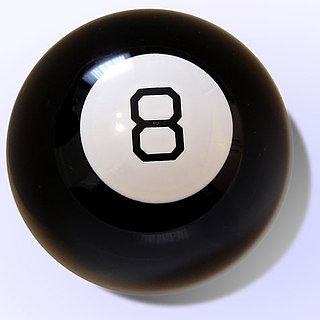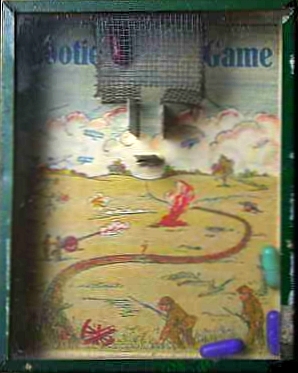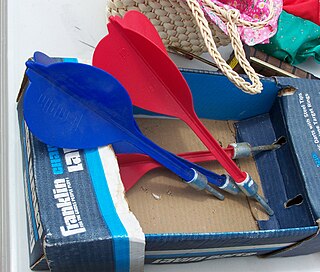
The Magic 8 Ball is a plastic sphere, made to look like an oversized eight ball, that is used for fortune-telling or seeking advice. It was invented in 1946 by Albert C. Carter and Abe Bookman and is currently manufactured by Mattel. The user asks a yes–no question to the ball, then turns it over to reveal an answer that floats up into a window.

Jenga is a game of physical skill created by British board game designer and author Leslie Scott and marketed by Hasbro. The name comes from the Swahili word "kujenga" which means 'to build or construct'. Players take turns removing one block at a time from a tower constructed of 54 blocks. Each block removed is then placed on top of the tower, creating a progressively more unstable structure. The game ends when the tower falls over.

Bandai Co., Ltd. is a Japanese multinational toy manufacturer and distributor headquartered in Taitō, Tokyo. Its international branches, Bandai Namco Toys & Collectables America and Bandai UK, are respectively headquartered in Irvine, California, and Richmond, London. Since 2006, Bandai is the toy production division of Bandai Namco Holdings. Between 1981 and 2001, Bandai was a manufacturer of video game consoles.

Playmobil is a German line of toys produced by the Brandstätter Group, headquartered in Zirndorf, Germany. The signature Playmobil toy is a 7.5 cm (3.0 in) tall human figure with a smiling face. A wide range of accessories, buildings and vehicles, as well as many sorts of animals, are also part of the Playmobil line.

Wham-O Inc. is an American toy company based in Carson, California, United States. It is known for creating and marketing many popular toys for nearly 70 years, including the Hula hoop, Frisbee, Slip 'N Slide, Super Ball, Trac-Ball, Silly String, Hacky sack, Wham-O Bird Ornithopter and Boogie Board, many of which have become genericized trademarks.

Cooties is a fictitious childhood disease, commonly represented as childlore. It is used in the United States, Canada, Australia, New Zealand, and the Philippines as a rejection term and an infection tag game. It is similar to the British 'dreaded lurgi', and to terms used in the Nordic countries, in Italy, India and Iraq. A child is said to "catch" cooties through close contact with an "infected" person or from an opposite-sex child of a similar age.
The Mego Corporation is an American toy company that in its original iteration was first founded in 1954. Originally known as a purveyor of dime store toys, in 1971 the company shifted direction and became famous for producing licensed action figures, celebrity dolls, and the Micronauts toy line. For a time in the 1970s, their line of 8-inch-scale action figures with interchangeable bodies became the industry standard.

Lawn darts is a lawn game for two players or teams. A lawn dart set usually includes four large darts and two targets. The game play and objective are similar to those of both horseshoes and darts. The darts are typically 12 inches (30 cm) in length with a weighted metal or plastic tip on one end and three plastic fins on a rod at the other end. The darts are intended to be tossed underhand toward a horizontal ground target, where the weighted end hits first and sticks into the ground. The target is typically a plastic ring, and landing anywhere within the ring scores a point.

Don't Break the Ice is a children's tabletop game for two to four players ages 3 and up. First marketed by Schaper Toys in 1968, the game was sold to Hasbro subsidiary Milton Bradley in 1986. It is still in production, and special editions were released in conjunction with the films Frozen (2013) and Frozen II (2019).

The Easy-Bake Oven is a working toy oven introduced in 1963 by Kenner and currently manufactured by Hasbro. The original toy used a pair of ordinary incandescent light bulbs as a heat source; current versions use a true heating element. Kenner sold 500,000 Easy-Bake Ovens in the first year of production. By 1997, more than 16 million Easy-Bake Ovens had been sold.

A product recall is a request from a manufacturer to return a product after the discovery of safety issues or product defects that might endanger the consumer or put the maker/seller at risk of legal action.

Playskool is an American brand of educational toys and games for children. The former Playskool manufacturing company was a subsidiary of the Milton Bradley Company and was headquartered in Chicago, Illinois. Playskool's last remaining plant in the aforementioned city was shut down in 1984, and Playskool became a brand of Hasbro, which had acquired Milton Bradley that same year.
Tyco Toys was an American toy manufacturer. It was acquired by Mattel in 1997, becoming one of its brands.

Ideal Toy Company was an American toy company founded by Morris Michtom and his wife, Rose. During the post–World War II baby boom era, Ideal became the largest doll-making company in the United States. Their most popular dolls included Betsy Wetsy, Toni, Saucy Walker, Shirley Temple, Miss Revlon, Patti Playpal, Tammy, Thumbelina, Tiny Thumbelina, and Crissy. The company is also known for selling the Rubik's Cube.
Ants in the Pants is a game designed by Marvin Glass and Associates, who sold the rights to William H. Schaper, and was originally produced in 1969 by Schaper's company Schaper Toys. In 1986 it was purchased by Hasbro, which still manufactures and markets the game.
Stompers are battery-powered toy cars that use a single AA battery and feature four-wheel drive. They are driven by a single motor that turns both axles. They were the first battery-powered, electric, true 4WD toys. Stompers were created in 1980 by A. Eddy Goldfarb and sold by Schaper Toys. Later, in the United Kingdom, Corgi Toys marketed identical toys in Corgi labeled packaging called Trekkers but made by Schaper. Genuine Stompers were sold by various companies around the globe and were also made by Schaper. There were similar products manufactured by Soma and LJN. Both companies were involved in lawsuits by Goldfarb and Schaper. Settlements were made and the companies continued their line of toys. As of 2019, Goldfarb continues to live and work at his design studio in Southern California.

Topper Corporation was a United States toy and board game manufacturer based in Elizabeth, New Jersey. The company, founded and run by Henry Orenstein, a holocaust survivor, produced toys under several brand names including: Johnny Lightning, Johnny Seven OMA, Dawn doll, and Suzy Homemaker.

Remco was an American toy company. Founded in the 1949 as Remco Industries, Inc., it is known for toys integrating technology and innovation from their inception.
Don't Spill the Beans is a children's game for 2 or more players ages 3–6 published by Milton Bradley Company, a subsidiary of Hasbro, Inc. The game was originally manufactured by Schaper Toys but acquired by Milton Bradley in 1986 through its then owner, Tyco Toys. The game is described by Hasbro as a "Classic Preschool Game. A Favorite For More Than 30 Years!".

Etch A Sketch is a mechanical drawing toy invented by André Cassagnes of France and subsequently manufactured by the Ohio Art Company. It is now owned by Spin Master of Toronto, Ontario, Canada.
















